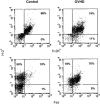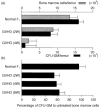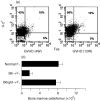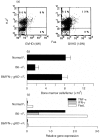Graft-versus-host-disease-associated donor cell engraftment in an F1 hybrid model is dependent upon the Fas pathway
- PMID: 10651946
- PMCID: PMC2327118
- DOI: 10.1046/j.1365-2567.2000.00919.x
Graft-versus-host-disease-associated donor cell engraftment in an F1 hybrid model is dependent upon the Fas pathway
Abstract
The graft-versus-host disease (GVHD) generated in BDF1 mice by the injection of spleen cells from the C57BL/6 parental strain induces a direct cell-mediated attack on host lymphohaematopoietic populations, resulting in the reconstitution of the host with donor cells. We examined Fas-Fas ligand (FasL) interactions in donor and host haematopoietic cells over a prolonged period of parental-induced GVHD. Fas expression on bone marrow cells of both donor and host origin increased at 2 weeks. Host cell incubation with anti-Fas antibody induced apoptosis, and the number of haematopoietic progenitor cells decreased. Fas-induced apoptosis by the repopulating donor cells, however, did not increase until 12 weeks, when more than 90% of the cells were donor cells. The expression of various cytokines, such as interferon-gamma (IFN-gamma) and tumour necrosis factor-alpha (TNF-alpha), and FasL gene expression in the bone marrow increased concomitantly. To examine directly whether FasL has a major role in the development of donor cell engraftment, FasL-deficient (gld) mice were used as donors. Injection of B6/gld spleen cells induced significantly less host lymphohaematopoietic depletion, resulting in a failure of donor cell engraftment. Furthermore, injection of IFN-gamma gene knockout (gko) B6 spleen cells failed to augment Fas and FasL expression in recipient mice, resulting in a failure of donor cell engraftment. This suggests that the induction of apoptosis by Fas-FasL interactions in host cells may contribute to a reconstitution of the host with donor cells and that donor-derived IFN-gamma plays a significant role for Fas-FasL interactions in host cells during parental-induced GVHD.
Figures





Similar articles
-
The role of donor T cells for target organ injuries in acute and chronic graft-versus-host disease.Immunology. 2001 Jul;103(3):310-8. doi: 10.1046/j.1365-2567.2001.01240.x. Immunology. 2001. PMID: 11454060 Free PMC article.
-
Cytokines in graft-versus-host disease and the graft-versus-leukemia reaction.Int J Hematol. 2001 Jul;74(1):26-32. doi: 10.1007/BF02982546. Int J Hematol. 2001. PMID: 11530801 Review.
-
Effect of graft-versus-host disease (GVHD) on host hematopoietic progenitor cells is mediated by Fas-Fas ligand interactions but this does not explain the effect of GVHD on donor cells.Cell Immunol. 1999 Oct 10;197(1):30-8. doi: 10.1006/cimm.1999.1553. Cell Immunol. 1999. PMID: 10555993
-
Differential expression of Fas and Fas ligand in acute and chronic graft-versus-host disease: up-regulation of Fas and Fas ligand requires CD8+ T cell activation and IFN-gamma production.J Immunol. 1998 Sep 15;161(6):2848-55. J Immunol. 1998. PMID: 9743345
-
Cytokines, viruses, and graft-versus-host disease.Curr Opin Hematol. 2002 Nov;9(6):479-84. doi: 10.1097/00062752-200211000-00002. Curr Opin Hematol. 2002. PMID: 12394168 Review.
Cited by
-
The role of donor T cells for target organ injuries in acute and chronic graft-versus-host disease.Immunology. 2001 Jul;103(3):310-8. doi: 10.1046/j.1365-2567.2001.01240.x. Immunology. 2001. PMID: 11454060 Free PMC article.
-
Cytokines in graft-versus-host disease and the graft-versus-leukemia reaction.Int J Hematol. 2001 Jul;74(1):26-32. doi: 10.1007/BF02982546. Int J Hematol. 2001. PMID: 11530801 Review.
-
Attenuation of GVHD for allo-bone marrow transplantation recipient by FasL-Fas pathway in an H-2 haplotype disparate mouse combination.J Huazhong Univ Sci Technolog Med Sci. 2004;24(4):329-33. doi: 10.1007/BF02861860. J Huazhong Univ Sci Technolog Med Sci. 2004. PMID: 15587391
-
The complex and central role of interferon-γ in graft-versus-host disease and graft-versus-tumor activity.Immunol Rev. 2014 Mar;258(1):30-44. doi: 10.1111/imr.12151. Immunol Rev. 2014. PMID: 24517424 Free PMC article. Review.
References
-
- Hakim FT, Shearer GM. Abrogation of hybrid resistence to bone marrow engraftment by graft‐vs‐host‐induced immune deficiency. J Immunol. 1986;137:3109. - PubMed
-
- Rolink AG, Radaszkiewicz T, Pals ST, van der Meer WG, Gleichmann E. Allosuppressor and allohelper T cells in acute and chronic graft‐vs‐host disease. I. Alloreactive suppressor cells rather than killer T cells appear to be the decisive effector cells in lethal graft‐vs‐host disease. J Exp Med. 1982;155:1502. - PMC - PubMed
-
- Iwasaki T, Fujiwara H, Iwasaki T, Shearer GM. Loss of proliferative capacity and T cell immune development potential by bone marrow from mice undergoing a graft‐vs‐host reaction. J Immunol. 1986;137:3100. - PubMed
-
- Hakim FT, Sharrow SO, Payne S, Sheare GM. Repopulation of host lymphohematopoietic systems by donor cells during graft‐versus‐host reaction in unirradiated adult F1 mice injected with parental lymphocytes. J Immunol. 1991;146:2108. - PubMed
MeSH terms
Substances
LinkOut - more resources
Full Text Sources
Medical
Molecular Biology Databases
Research Materials
Miscellaneous

